
A science museum is a museum devoted primarily to science. Older science museums tended to concentrate on static displays of objects related to natural history, paleontology, geology, industry and industrial machinery, etc. Modern trends in museology have broadened the range of subject matter and introduced many interactive exhibits. Modern science museums, increasingly referred to as 'science centres' or 'discovery centres', also feature technology.
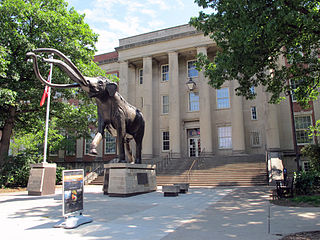
The University of Nebraska State Museum, also known as Morrill Hall, founded in 1871, is a natural history museum featuring Nebraska biodiversity, paleontology, and cultural diversity, located on the University of Nebraska–Lincoln City Campus near the corner of 14th and Vine Streets in Lincoln, Nebraska, United States. The museum houses Mueller Planetarium, a hands-on science discovery center, and the Elephant Hall, where visitors can see the world's largest articulated fossil mammoth among the collection of fossil elephants. Also featured are interactive paleontology exhibits, a dinosaur gallery, ancient life and evolution exhibits, wildlife dioramas, gems and minerals, American Indian and African exhibits, and a temporary exhibit gallery featuring rotating displays on diverse topics including photography, quilts and fine arts.
The City of Arts and Sciences is a cultural and architectural complex in the city of Valencia, Spain. It is the most important and modern tourist destination in the city of Valencia and one of the 12 Treasures of Spain.

Science North is an interactive science museum in Greater Sudbury, Ontario, Canada.

The Museum of Science (MoS) is a nature and science museum and indoor zoological establishment located in Science Park, a plot of land in Boston and Cambridge, Massachusetts, spanning the Charles River. Along with over 700 interactive exhibits, the museum features a number of live and interactive presentations throughout the building each day, along with scheduled film showings at the Charles Hayden Planetarium and the Mugar Omni Theater. Additionally, the Museum of Science is an accredited member of the Association of Zoos and Aquariums (AZA), being home to over 100 animals—many of which have been surrendered, confiscated, rescued or rehabilitated.
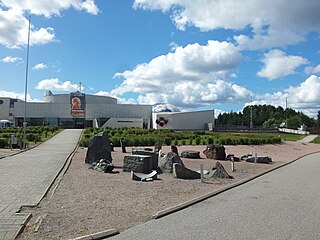
Heureka is a Finnish science center in the Tikkurila district of Vantaa, Finland, north of Helsinki, designed by Heikkinen – Komonen Architects. It is located at the intersection of the Finnish Main Line and the river Keravanjoki.

The Denver Museum of Nature & Science is a municipal natural history and science museum in Denver, Colorado. It is a resource for informal science education in the Rocky Mountain region. A variety of exhibitions, programs, and activities help museum visitors learn about the natural history of Colorado, Earth, and the universe. The 716,000-square-foot (66,519 m2) building houses more than one million objects in its collections including natural history and anthropological materials, as well as archival and library resources.

The Houston Museum of Natural Science is a natural history museum located on the northern border of Hermann Park in Houston, Texas, United States. The museum was established in 1909 by the Houston Museum and Scientific Society, an organization whose goals were to provide a free institution for the people of Houston focusing on education and science. The museum complex consists of a central facility with four floors of natural science halls and exhibits, the Burke Baker Planetarium, the Cockrell Butterfly Center, and the Wortham Giant Screen Theatre. In 2022, the museum received 1,520,000 visitors, making it seventh on the List of most-visited museums in the United States, and was the third most-visited U.S. science museum. Much of the museum's popularity is attributed to its large number of special or guest exhibits.
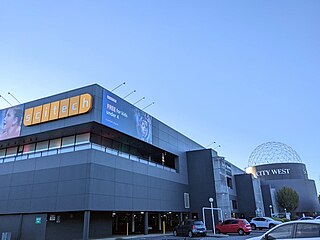
Scitech is a not-for-profit company encompassing the Scitech Discovery Centre, an interactive science museum in West Perth, Western Australia, outreach programs, professional learning programs and digital content.
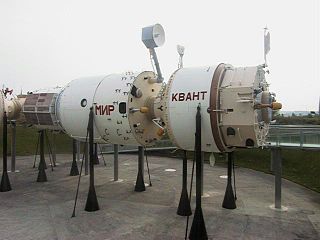
The Cité de l'espace is a scientific discovery centre in France focused on spaceflight. It was opened in June 1997, and is located on the eastern outskirts of Toulouse. It was carried out on the initiative of the Town Hall of Toulouse with the participation of numerous partners such as the Regional Council of Midi-Pyrénées, the Ministries of Equipment, Transport, Defence, National Education, Research and Technology, the National Center for Space Studies (CNES), Météo-France, EADS, Astrium, among others. As of 2012, there had been more than four million visitors.

Thessaloniki Science Center and Technology Museum (NOESIS) is a science and technology located in Thermi at the outskirts of Thessaloniki, Central Macedonia, Greece. The museum is actively engaged in the protection of the Greek technological heritage. In addition to technological exhibits on its premises, it houses various types of facilities, such as a planetarium, an amphitheatre, a simulation room, and a wide-screen cinema for the projection of educational programs.
The Science Center for Education is a science museum in Khlong Toei District, Bangkok, Thailand. It is located next to the Eastern Bus Terminal (Ekkamai) on Sukhumvit Road, and is a science exhibition center. It includes an aquarium, a computer world, a planetarium, and workshops/devices intended for children.

Museo de la Naturaleza y Arqueología (MUNA), is a museum-based in Santa Cruz de Tenerife, Tenerife,. It contains many significant archaeological finds and is considered the best repository of objects from the Pre-Castilian Canary Islands. The museum also houses significant paleontological, botanical, entomological, and marine and terrestrial vertebrate collections, and is considered the best Natural Library of the Canary Islands.

Copernicus Science Centre is a science museum standing on the bank of the Vistula River in Warsaw, Poland. It contains over 450 interactive exhibits that enable visitors to single-handedly carry out experiments and discover the laws of science for themselves. The centre is the largest institution of its type in Poland and one of the most advanced in Europe. In 2018, since its opening, it has been visited by over 8 million people.

La Casa de la Ciencia in the city of Seville, Spain is a centre for popularizing science.

Valladolid Science Museum was opened in May 2003 as a museum and an iconic piece of architecture based on an old flour mill. Rafael Moneo and Enrique de Teresa used a lot of the old industrial complex to create this new Science Museum.
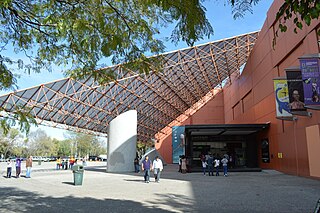
Universum is Mexico's primary museum dedicated to promoting science and technology to the public as well as support the university's science missions. It was opened in 1992 at the Ciudad Universitaria in Mexico City. Today it has thirteen halls divided by theme dedicated to various permanent exhibitions. It has worked with outside public and private entities to develop both permanent and temporary exhibitions and has worked to develop other science museums in other areas of the country.

Techmania Science Center is one of the first science centers in the Czech Republic and an important institution of informal education. The project was established in 2005 by the Škoda Transportation joint-stock company and the University of West Bohemia in Pilsen. The intention has been to build up a modern, interactive center in the industrial estate of the Škoda company.

The Elder Museum of Science and Technology is a museum in Las Palmas, the capital city of Gran Canaria in the Canary Islands.






















